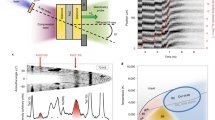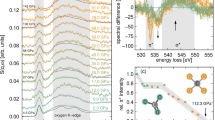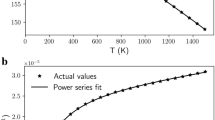Abstract
THE major increases in density occurring at depths of 400–1,000 km in the Earth's mantle require the formation of phases in which silicon is six-coordinate. Such coordination has been demonstrated in stishovite (SiO2 of rutile type1), in the hollandite form of feldspar compositions2, in the garnet form of (Mg,Fe)SiO33, in garnet-type MnSiO34, in perovskite-type CaSiO33 and in SiP2O75—but examples are still few. For the two compositional types believed to provide the bulk of the mantle, ASiO3 and A2SiO4 where A is Mg or Fe, high pressure phase transformations of numerous model compounds such as MnGeO3, CaGeO36, Mn2GeO4, and Ca2GeO47 have demonstrated the possibility of high pressure ilmenite, perovskite, strontium plumbate and potassium nickel fluoride forms, respectively, as ultimate high pressure silicate phases; and disproportionation into simple oxides has also been discovered8,9. In the absence of directly observed silicate transformations it is important to delineate the systematic crystal chemistry of each of these structural classes, particularly for those members containing ions closest in size to Fe, Mg and Si, and to obtain further examples of six-coordinate silicon in a range of compounds.
This is a preview of subscription content, access via your institution
Access options
Subscribe to this journal
Receive 51 print issues and online access
$199.00 per year
only $3.90 per issue
Buy this article
- Purchase on Springer Link
- Instant access to full article PDF
Prices may be subject to local taxes which are calculated during checkout
Similar content being viewed by others
References
Stishov, S. M., and Belov, N. V., Dokl. Akad. Nauk SSSR, 143, 951 (1962).
Reid, A. F., and Ringwood, A. E., J. Solid State Chem., 1, 6 (1969).
Ringwood, A. E., and Major, A., Earth planet. Sci. Lett., 12, 411 (1971).
Akimoto, S., and Syono, Y., Tech. Rept Inst. Solid State Phys., Univ. Tokyo, Ser. A, No. 469, June 1971.
Liebau, F., and Hesse, K. F., Z. Kristallogr. Kristallgeom., 133, 213 (1971).
Ringwood, A. E., and Major, A., Earth planet. Sci. Lett., 2, 106 (1967).
Reid, A. F., and Ringwood, A. E., J. Solid State Chem., 1, 557 (1970).
Ming, L. C., and Bassett, W. A., EOS, 55, 716 (1974).
Kumazawa, M., Sawamoto, H., Ohtani, E., and Masaki, K., Nature, 247, 356 (1974).
Marezio, M., Remeika, J. P., and Dernier, P. D., Acta crystallogr., B 26, 2008 (1970).
Gibbs, G. V., and Smith, J. V., Am. Miner., 50, 2023 (1965).
Davies, G. F., and Gaffney, E. S., Geophys. J., 33, 165 (1973).
Baur, W. H., and Khan, A. A., Acta crystallogr., B 27, 2133 (1971).
Goodenough, J. B., and Longo, J. M., Landolt-Bornstein, Numerical Data and Functional Relationships in Science and Technology (New Series), Group III, Vol. 4a (edit. by Hellwege, K.-H., and A. M.), chap. 3 (Springer, Berlin, 1970).
Shannon, R. D., and Bierstedt, P. E., J. Am. ceram. Soc., 53, 635 (1970).
Shimuzu, Y., Syono, Y., and Akimoto, S., High Temperatures, High Pressures, 2, 113 (1970).
Author information
Authors and Affiliations
Rights and permissions
About this article
Cite this article
REID, A., RINGWOOD, A. New dense phases of geophysical significance. Nature 252, 681–682 (1974). https://doi.org/10.1038/252681a0
Received:
Revised:
Issue Date:
DOI: https://doi.org/10.1038/252681a0
Comments
By submitting a comment you agree to abide by our Terms and Community Guidelines. If you find something abusive or that does not comply with our terms or guidelines please flag it as inappropriate.



